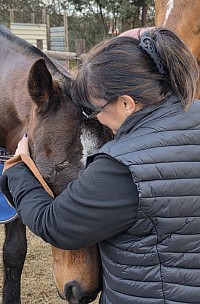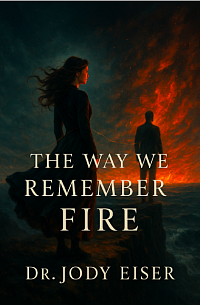Keep up to date with the latest Blogs and Trends
The Pain You Can't See: Living With Chronic Pain Without Scars or Deformities
One of the most difficult parts of living with chronic pain is that there’s often nothing visible to “prove” it exists. There are no scars, no casts, no deformities. From the outside, you might look perfectly fine. But inside, every day is a quiet war—aching joints, muscles that don’t respond the way they should, and a fatigue so heavy it feels stitched into your bones. And you dare not say anything or moan or else you are a hypochondriac.
The Invisibility of Pain
When pain is invisible, the world doesn’t always know how to respond. People expect evidence - limps, bruises, bandages. Without those indicators, it’s easy for others to dismiss or misunderstand what you are going through. They may say, “But you look so healthy” or “You’re too young to feel this way.” Those words can feel like salt on an already raw wound.
What many don’t see is the toll it takes to simply get through a day: the careful rationing of energy, the constant negotiation between what your body demands and what life requires of you.
The Spoon Theory
Christine Miserandino’s Spoon Theory has become a lifeline for many of us who live with chronic pain and chronic illness. It’s a way to explain the daily budgeting of energy -because unlike others, we don’t have endless “spoons” (energy) to use up in a day.
Getting dressed might cost a spoon.Making breakfast, another.A meeting at work? Two or three.
By mid-afternoon, the spoons run low, and every decision becomes one of survival: Do I cook dinner or shower? Do I go out with friends or rest so I can get through tomorrow?
This isn’t laziness - it’s strategy. It’s survival.
The Horrific Side Effects of Medication
Living with chronic pain often means living with a shelf full of pill bottles that grow by the day. You take a pill for one thing and another for the side effect of that. Some days, the medications dull the pain just enough to function; other days, they add a whole new set of battles. The side effects can feel like a cruel trade-off.
It’s devastating to realise that the very thing meant to bring relief often takes something else from you. You swallow the pill to ease the pain in your joints, only to feel your stomach turn in knots. You take the tablet to sleep, and instead you wake up groggy, heavy, and emotionally flat.
This double-edged sword is a part of chronic pain no one talks about enough. The pain is constant, but so is the negotiation with your body and the pharmacy shelf—asking yourself, Which side effects can I survive today?
Fatigue That Doesn’t Show
The fatigue of chronic pain is not the kind that goes away after a good night’s sleep. In fact there are not many that get a good night’s sleep with such conditions, and if they do, they still wake up exhausted. It’s relentless. It seeps into muscles, thoughts, and emotions. You might stand in a room and smile, but inside you’re wondering if you’ll have enough energy to drive home safely. It’s the kind of exhaustion few can grasp unless you have lived it.
Coping With the Unseen
There is no single fix, but there are ways to soften the edges:
Prioritizing: Choosing what truly matters and letting go of what drains without adding value. Mel Robbins Let them, Let me is such a beautiful adage to note here.
Gentle compassion: Allowing yourself to rest without guilt, to say no without apology. A little bit of kindness towards yourself even when no one else can give it.
Connection: Finding people who “get it.” Finding community and support groups with those like goes a long way to being seen, validated, and understood.
Tiny joys: A cup of tea, a stretch in the sunlight, a good book - moments that restore a spoon or two.
It is not all doom and gloom though! There are also some alternative ways of healing, including somatic breathing, visual imagery, NLP techniques, so please do not give up! These can all add up to a better day.
A Quiet Strength
Strength, when you live with daily pain, is not about conquering mountains. It’s about carrying on when the mountain lives inside your body. It’s about knowing your worth isn’t diminished by what others can or cannot see.
So if you’re navigating life with chronic pain - without scars, without visible signs - remember this: you are not invisible. Your struggle is real. Your resilience is extraordinary. And you are not alone.
✨ Every day you carry the unseen weight of pain, and every day you rise anyway. That is its own kind of courage.✨
Please listen to the parent-child-relationship talk I was honored to be a part of on ChaiFM (109FM)
https://www.chaifm.com/podcast/2025-08-25-gabriella-mendelson-dr-jody-eiser-parent-child-relationship-in-preparation-for-elul/?utm_source=rss&utm_medium=rss&utm_campaign=2025-08-25-gabriella-mendelson-dr-jody-eiser-parent-child-relationship-in-preparation-for-elul
Helping Your Child Navigate Exam Stress: A Parent's Guide
Exam season can be overwhelming for children and parents alike. While some stress is normal and can even be motivating, excessive anxiety can hinder performance and wellbeing. Here's how you can support your child through this challenging time.
Create a Supportive Environment
Establish routines that provide stability. Consistent sleep schedules, regular meals, and designated study times help children feel more in control. Avoid making major household changes during exam periods.
Design a calm study space free from distractions. Ensure good lighting, comfortable seating, and all necessary materials are within reach. Let siblings know when quiet time is needed.
Encourage Healthy Study Habits
Break study sessions into manageable chunks using techniques like the Pomodoro method (25 minutes focused study, 5-minute break). This prevents mental fatigue and improves retention.
Help them prioritize subjects based on exam dates and difficulty levels. Create a realistic study schedule together, building in buffer time for challenging topics and reviews.
Promote active learning through summarizing, teaching concepts back to you, or creating mind maps rather than passive reading.
Support Their Emotional Wellbeing
Listen without immediately offering solutions. Sometimes children just need to voice their worries. Validate their feelings with phrases like "It sounds like you're feeling overwhelmed."
Teach simple stress-relief techniques such as deep breathing exercises, brief walks, or stretching. Model these behaviors yourself when you feel stressed. You are your children's primary teachers!
Maintain perspective by reminding them that exams are important but don't define their worth. Share stories of successful people who struggled academically or took unconventional paths.
Practical Support Strategies
Ensure proper nutrition with brain-healthy foods like nuts, fish, fruits, and vegetables. Avoid excessive caffeine and sugar that can increase anxiety.
Encourage regular physical activity, even if just 15-20 minutes daily. Exercise is one of the most effective stress relievers and improves cognitive function.
Monitor their workload and step in if you notice signs of burnout like irritability, sleep problems, or physical symptoms. It's okay to encourage breaks.
Know When to Seek Help
Watch for warning signs that stress has become overwhelming: persistent sleep issues, loss of appetite, frequent emotional outbursts, or statements about feeling hopeless. Don't hesitate to contact school counselors or healthcare professionals if needed.
Remember: You're the Steady Presence
Your calm, supportive presence is often more valuable than any study tip. Children take cues from their parents' emotional state, so managing your own stress about their performance is equally important.
Exam success isn't just about grades-it's about developing resilience, time management, and healthy coping strategies that will serve them throughout life. By focusing on the process rather than just outcomes, you're teaching valuable life skills that extend far beyond any single test.
The Ghosts We Bring to Love: How Yesterday's Wounds Whisper in Today's Hearts
"I don't think you're ready to hear this," she said, watching her client's hands shake around a tissue twisted into nothing. But aren't we all carrying something we're not ready to name?"
There's a moment in every relationship when the past arrives uninvited. It doesn't knock. It doesn't announce itself with fanfare. It simply settles into the space between heartbeats, whispering familiar fears into present moments that deserve better.
You know the feeling. Your partner's phone buzzes, and suddenly you're seventeen again, watching someone else choose anyone but you. They go quiet for a day, and the silence tastes like every goodbye you've ever swallowed. They laugh differently-warmer, lighter-and some ancient part of you remembers when laughter left and never came back.
This is the peculiar ache of loving while haunted. Of trying to build something new while carrying the rubble of what came before.
The Architecture of Old Pain
Our hearts are archaeologists, collecting evidence of every betrayal, every abandonment, every moment we were too much or not nearly enough. These experiences don't simply fade-they calcify into protective wisdom, whispering instructions for survival: Don't trust the soft words. Don't believe in forever. Don't get comfortable in love's cathedral because someone always leaves the altar empty.
The mind, in its fierce devotion to keeping us alive, creates templates from our wounds. If love once meant criticism, we flinch at feedback. If intimacy meant invasion, we armor ourselves in distance. If devotion meant disappearance, we learn to love with one foot always pointed toward the exit.
But here's what the mind doesn't understand: the very mechanisms that once saved us can slowly strangle the love we're desperate to keep.
When Yesterday Bleeds Into Today
Watch how it happens. She texts "We need to talk" and your chest constricts with the memory of every conversation that ended in goodbye. He seems distracted, and suddenly you're translating his silence through the language of every person who made you feel invisible. They need space, and your nervous system translates this as the beginning of the end-because hasn't it always been?
These aren't logical responses. They're archaeological ones. Your body remembers what your mind tries to forget: how it felt to be left, to be lied to, to discover that promises have expiration dates written in invisible ink.
The tragedy isn't that we carry these imprints-it's that we mistake them for prophecy instead of history.
The Nervous System's Fierce Protection
Your triggers aren't character flaws. They're love letters from your nervous system, written in the desperate handwriting of survival. Every flinch, every wall, every moment you choose distance over vulnerability-these are your psyche's attempts to save you from experiencing that particular shade of devastation again.
But protection and connection exist in constant tension. The very mechanisms that keep us safe also keep us separate. We become experts at reading danger in gentle gestures, at translating kindness through the grammar of past hurts.
The Alchemy of Awareness
Healing doesn't happen in the bright light of understanding-it happens in the tender darkness of compassion. It begins not with fixing yourself, but with befriending the frightened parts of you that are just trying to keep you whole.
Name the ghost. When your chest tightens, when your mind spirals, when you feel that familiar surge of panic or rage-pause. Ask: What year is this feeling from? Whose voice am I hearing? What old wound is asking for attention?
Breathe space between trigger and response. There's a moment-sometimes milliseconds-between the trigger and your reaction. Practice living in that space. Breathe there. Let your present self speak instead of your past self's panic.
Separate then from now. Your current partner is not your ex. This conversation is not that conversation. This silence is not that silence. Practice saying: This is not the same story. This is not the same ending.
Communicate from the wound, not through it. Instead of "You're just like everyone else who leaves," try "I'm feeling scared right now because my past is telling me stories about this moment. Can you help me separate then from now?"
Creating New Neural Pathways
The brain that learned to fear can learn to trust. The heart that learned to armor can learn to soften. But this requires practice, patience, and the radical act of choosing differently even when every instinct screams for the familiar protection of walls.
Practice somatic awareness. Your body holds the memory of every hurt and every healing. Learn its language. Notice where you hold tension, how your breath changes, what physical sensations accompany emotional triggers. Movement, breathwork, and body-based practices can help release what talk therapy sometimes cannot reach.
Cultivate witnesses, not rescuers. Surround yourself with people who can hold space for your process without trying to fix you. Sometimes we need someone to sit with us in the mess, not pull us out of it.
Honor the pace of healing. Trauma time is not linear time. Some days you'll feel strong and clear. Others, you'll feel like you're drowning in yesterday's rain. Both are part of the process. Both deserve compassion.
Love as an Act of Courage
To love after being wounded is perhaps the most courageous thing we do. It requires us to believe in something we cannot guarantee, to invest in something that might break, to offer our hearts to another person's imperfect hands and trust that they will hold us with care.
But real love-soul love-isn't about finding someone who will never trigger you. It's about finding someone who will stay with you while you untangle yesterday's knots. Someone who won't take your healing personally. Someone who understands that your flinching isn't about them-it's about the story your nervous system is still trying to rewrite.
The Ripple Effect of Healing
When we heal our relationship to our own woundedness, everything changes. We stop expecting our partners to be mind readers. We stop punishing them for crimes they didn't commit. We stop living as if love is something that happens to us instead of something we actively create.
We learn to love from wholeness instead of wounds. From presence instead of past. From choice instead of compulsion.
And in that space-that sacred space between trigger and response, between wound and wisdom-we discover something revolutionary: we can write new endings. We can choose differently. We can love, and be loved, not despite our scars but including them.
The Long Return Home
Healing isn't about becoming unbreakable. It's about learning to break beautifully-to let our cracks be places where light gets in instead of walls where love gets blocked. It's about recognizing that our sensitivity isn't a burden to be managed but a gift to be honored.
Your past taught you to survive. Your present is teaching you to thrive. The difference between the two is the space you create between reaction and response, between then and now, between the story that was written on your heart and the one you're brave enough to write next.
Love is not a return to innocence. It's an arrival at wisdom. It's choosing to trust again, not because you're certain you won't be hurt, but because you're certain you can survive being whole.
The ghosts we bring to love are not intruders-they are teachers. And the greatest lesson they offer is this: you survived the wounding. You can survive the healing. You can survive being loved exactly as you are.
Key Takeaways
1. Our past relationship wounds create protective triggers that can sabotage current love. When we're hurt before, our nervous system learns to read danger in innocent moments-a delayed text becomes abandonment, silence becomes rejection.
2. The key to healing isn't eliminating triggers but creating space between the trigger and our response. We learn to ask: What year is this feeling from? and Is this the same story or a new one?
3. Real love isn't finding someone who never triggers you-it's finding someone who stays while you untangle yesterday's knots. Healing happens when we love from wholeness instead of wounds, choosing to write new endings rather than repeating old patterns.
Your past taught you to survive. Your present is teaching you to thrive!
The Healing Power of Horses: When Hearts Connect Beyond Words
There are moments in life when healing arrives not through medicine or therapy sessions, but through the simplest, most profound gestures. I had not been out with the horses in a long time and I got to spend five days with them again. Nothing was more important than that Monday afternoon. For me, that moment when one of the horses, Sdu, gently rested its head on my shoulder, then drew closer, pressing its warm face against my chest in what could only be described as an embrace. This is magic in its truest form!
The Unexpected Embrace
I wasn't seeking therapy that day. I was simply spending time with horses, perhaps looking for a moment of peace after what had been a difficult period for me. But as I stood quietly beside this gentle giant, something shifted. Without warning or invitation, the horse moved closer, lowering its massive head to rest on my shoulder. The weight was both physical and emotional-a grounding presence that seemed to anchor me to the present moment.
Then came the embrace. The horse pressed its head against my chest, and I felt something I hadn't experienced in months: complete acceptance, validation. There was no judgment in that gesture, no expectation, no need for words or explanations. Just pure, unconditional presence.
The Magic of Wordless Communication
What struck me most was how this healing happened without language. The horse didn't need to know my story, my struggles, or my pain. It simply offered what it had: warmth, presence, and an intuitive understanding that transcended human comprehension. In that moment, I understood why horses have been humanity's partners for thousands of years-they possess an ancient wisdom about connection and healing that we've perhaps forgotten.
The horse's breath was steady and calm against my chest, and I found my own breathing naturally synchronizing with its rhythm. My racing thoughts slowed, my tense muscles began to release, and for the first time in weeks, I felt truly at peace. This was a perfect moment, my perfect day....
Understanding Equine Therapy
This personal experience gave me profound insight into why equine-assisted therapy is such a powerful healing modality. Horses are prey animals, which means they've evolved to be incredibly sensitive to energy, emotions, and authenticity. They can detect our emotional state before we're even fully aware of it ourselves.
In equine therapy, horses serve as both mirrors and healers. They reflect our inner state without judgment while offering their calm, grounding presence. Unlike human therapists who work primarily through conversation and cognitive processes, horses work through being-through presence, touch, and energetic connection.
The Science Behind the Magic
Research has shown that interaction with horses can lower cortisol levels, reduce blood pressure, and release oxytocin-the "bonding hormone" that promotes feelings of trust and connection. But beyond the biochemical responses, there's something deeper at work. Horses live entirely in the present moment, and their presence invites us to do the same.
When that horse rested its head on my shoulder, it wasn't dwelling on the past or worrying about the future. It was simply being present with me, and in that presence, I found my own ability to just be.
The Healing Process
Equine therapy works because horses are honest. They don't pretend to feel something they don't, and they don't respond to false emotions or forced interactions. They will show you how to communicate with them and if they do not like it, they will walk away. If you're anxious, they'll sense it. If you're angry, they'll know. But if you're genuine and present, they'll meet you there with their own authentic presence. There is nothing more honest and beautiful.
This honesty creates a safe space for healing. With horses, you can't hide behind masks or pretences. You must be real, and in that authenticity, healing becomes possible.
Lessons from My Four-Legged Healer
That day, my equine friend reminded me of several profound lessons:
Healing doesn't always require words. Sometimes, the most powerful therapy comes through presence, touch, and shared silence.
Acceptance is medicine. The horse's unconditional acceptance of me in that moment was more healing than any advice or analysis could have been.
Connection transcends species. The bonds we form with animals can be just as meaningful and therapeutic as those we form with humans.
Present-moment awareness is healing. By drawing me into the present moment, the horse helped quiet the anxious chatter of my mind.
The Ripple Effect
The healing I experienced that day didn't end when I left the stable. It created ripples that extended into my daily life. I found myself more grounded again, more present, and more open to connection with others. The horse had reminded me of something essential: that healing often happens not through fixing or changing, but through being seen, accepted, and loved exactly as we are.
Finding Your Own Healing
If you're struggling with emotional pain, trauma, or simply feeling disconnected from yourself and others, consider the possibility that healing might come in unexpected forms. It might come through the gentle nuzzle of a horse, the warmth of an embrace, or the simple act of being present with another living being.
Equine therapy programs exist worldwide, offering structured opportunities to experience the healing power of horses. But even informal time spent with horses can be transformative. These magnificent animals have a gift for meeting us exactly where we are and offering us exactly what we need.
A Final Thought
As I reflect on that healing moment, I'm reminded that sometimes the most profound medicine comes not from what we do, but from what we allow ourselves to receive. Sdu offered me a gift that day—the gift of presence, acceptance, and unconditional love. In accepting that gift, I discovered that healing doesn't always require fixing. Sometimes, it simply requires being held.
The next time you find yourself in need of healing, remember that it might come from the most unexpected source. It might come from a horse who rests its head on your shoulder and reminds you that you are worthy of love, exactly as you are.
Key Takeaways
1. Healing Through Presence, Not Words
The most profound healing often occurs through simple presence and authentic connection rather than traditional therapy or conversation. My transformative experience came through a horse's gentle embrace - a wordless communication that provided complete acceptance and validation without judgment or expectation.
2. Horses as Natural Healers and Mirrors
Horses possess an intuitive ability to sense and respond to human emotions due to their evolution as prey animals. They serve as both mirrors, reflecting our inner emotional state, and healers, offering their calm, grounding presence. Their honesty and authenticity create safe spaces where people must be genuine, making healing possible through real connection.
3. The Power of Present-Moment Awareness
Horses live entirely in the present moment and invite humans to do the same. This presence has measurable benefits - lowering cortisol, reducing blood pressure, and releasing oxytocin. I found my racing thoughts slowed and tense muscles relaxed simply by synchronizing with the horse's calm breathing rhythm.
4. Acceptance as Medicine
The unconditional acceptance offered by the horse proved more healing than traditional therapeutic approaches. This experience demonstrates that sometimes healing doesn't require fixing or changing ourselves, but rather being seen, accepted, and loved exactly as we are. The healing created lasting ripple effects, making the author more grounded and open to connection in daily life.
New Book Just Published
Some stories find us when we need them most — reminding us how love can mend what life has broken.
I’m honoured to share The Way We Remember Fire — my new novel about soul recognition, healing, and the fierce beauty of intimacy that transforms us.
This book is for anyone who has ever believed in second chances, in the fire we carry for each other, and in the quiet power of remembering who we really are when we love bravely.
If this story resonates with you, I’d be deeply grateful if you’d read, share, and help me spread its warmth.
Available now on Amazon & Kindle.
📖✨ #TheWayWeRememberFire #NewRelease #HealingThroughStory
Letting Go of Your Pain
Releasing pain is like setting down a burden you've carried for too long. With each step forward, you rediscover your strength, unshackled, lighter, ready to embrace what’s ahead.
Pain comes in many forms and links back to the wounds that we carry. It can be emotional or physical, and often feels like something we must endure, as though carrying it is a form of strength. But true strength lies in letting go of it. Letting go doesn’t mean forgetting or pretending it never happened - it means acknowledging it, learning from it, and choosing not to let it define your present or future.
Imagine pain as a heavy rock you've been carrying. At first, it feels necessary, familiar, even protective. We have been taught to carry this burden all too well. But over time, it weighs you down, making each step harder. Choosing to set it down is not a denial of its existence but a recognition that you don’t have to bear its full weight forever.
This process of release can be gradual. Sometimes, it starts with a quiet decision - to stop revisiting old wounds, to challenge the belief that suffering is required for growth, to replace sorrow with understanding. Healing is not linear, but each moment of release brings clarity and renewal. There may be times that you revisit this but you don't linger in it having learnt to be resilient.
Letting go of pain is a deeply transformative process that brings emotional relief and renewal. Here is how it helps:
Emotional Lightness – Carrying emotional pain can feel like dragging a weight through life, a rock on your shoulders. Releasing it brings a sense of freedom, making room for peace and contentment.
Clarity and Perspective – When pain lingers, it can cloud judgment and distort reality. Letting go allows you to see situations more objectively, leading to wiser decisions and healthier, deeper relationships.
Self-Compassion and Growth – Forgiveness - whether of yourself or others-fosters kindness and self-acceptance. Forgiveness is not about the other person, it is so they no longer have control over you, you are taking your power back. It helps you recognize your own resilience and move forward with confidence.
Restoration of Joy – Pain can dull life’s vibrant moments. When you loosen your grip on the hurt, joy has space to re-enter in different ways-through laughter, creativity, and meaningful connections.
Inner Strength – The ability to let go is a testament to personal strength. It signifies courage, bravery and-the choice to move beyond suffering and embrace healing. This choice is yours-own it and take your power back!
It’s not about forgetting or invalidating what happened to you. It’s about reclaiming your own well-being and deciding that pain will not define you and your future.
Reframing Suicide: A Compassionate Psychological Perspective
Describing suicide as “selfish” is a common but deeply problematic and oversimplified perspective. From a psychological point of view, suicide is rarely an act of selfishness—instead, it is more often the result of intense psychological pain, distorted cognitive processing, and a perceived absence of alternatives. As hard as this view is, from a Psychological perspective we need to view this with a compassionate understanding.
Here are a few key points to understand this better:
Cognitive Distortions and Psychological Risk Factors
People experiencing suicidal ideation often suffer from cognitive distortions, such as:
Black-and-white thinking (“Nothing will ever get better.”)
A sense of hopelessness (“There is no point in continuing.”)
Perceived burdensomeness (“Everyone would be better off without me.”)
These distortions, which have been found in psychological autopsy studies, are symptomatic of conditions like major depressive disorder, PTSD, bipolar disorder, or borderline personality disorder—they cloud perception and decision-making. Also, a history of self-harm increases suicide risk
Psychache (Psychological Pain) and Suicide as Escape
Suicide is often an attempt to escape unbearable psychological pain, a concept coined by psychologist Edwin Shneidman. The individual isn’t trying to hurt others; they are trying to stop their own suffering, which feels inescapable. Studies show that chronic emotional distress and feelings of entrapment are major contributors to suicidal behavior.
Impaired Functioning and Decision-making
Mental illness often leads to impaired emotional regulation, problem-solving abilities, and impulse control. These impairments make it extremely difficult for someone to consider other options or reach out for help. Research findings from the National Institute of Mental Health (NIMH) suggests that individuals at risk for suicide often experience neurological changes affecting both decision-making and emotional processing.
Isolation and Social Disconnection
People at risk for suicide frequently feel isolated, disconnected, and misunderstood. Their social support may be minimal or feel inaccessible, reinforcing the sense that they have no place in the world.
Myth of Selfishness and Stigma
Labeling suicide as “selfish” is harmful as it:
Invalidates the real suffering the person is experiencing.
Contributes to stigma, which discourages help-seeking.
Shifts blame rather than fostering empathy and support.
From a therapeutic perspective, it’s more compassionate and effective to view suicidal behavior as a maladaptive coping mechanism—not a moral failing.
In Summary:
Rather than selfishness, suicide is usually an act driven by desperation, mental illness, and a collapse of coping resources. Psychological interventions aim to address the underlying distress and help individuals reconnect with meaning, support, and hope. Compassionate Approach needs to be applied.
Finding the right therapist and much more....
Just wrapped a fantastic conversation with Eitan Engelberg. We dive deep into mental health and the stigma around therapy.
The conversation took some fascinating turns, especially when we explored: "How finding the right therapist is like dating, ensuring the perfect fit for personal growth."
Can't wait for you to hear the full episode, coming soon!
Mental Wellness in 2025: A New Era Of Awareness, But Are we Thriving?
In 2025, conversations about mental health are more visible and normalized than ever before. From viral TikTok's on self-care to celebrities opening up about therapy, the stigma surrounding mental wellness is slowly cracking. But beneath the hashtags and hotlines, a deeper question lingers: Are we truly well—or just surviving with better language to describe our stress?
Modern life is a paradox. We’re more connected, yet lonelier than ever. We’re more informed, yet overwhelmed. Technology promised convenience, but it also brought constant notifications, blurred work-life boundaries, and the pressure to always be on.
The result? Rising rates of anxiety, burnout, and disconnection.
According to recent data, global mental health disorders have continued to increase, especially among the Gen Z and Millennials. Social comparisons on curated feeds, climate anxiety, financial pressure, and political instability weigh heavily on the collective psyche.
The Wellness Industry: Help or Hype?
The booming wellness industry has responded with a flood of products—apps, supplements, meditations, digital detox challenges and let's not forget about the new generation of AI. While many are genuinely helpful, some offer a band-aid for deeper issues. True mental wellness requires more than lavender candles and inspirational quotes. It demands systemic change, trauma-informed care, and safe spaces for vulnerability.
Therapy and Telehealth: A Bright Spot
One of the most promising shifts has been the rise of accessible therapy through telehealth. Virtual counseling has broken geographical and logistical barriers, allowing more people to access professional support. Therapists are also integrating culturally-sensitive and trauma-informed approaches, recognizing that healing isn’t one-size-fits-all. Each client deserves focused attention and care!
Community Is Medicine
More people are rediscovering that mental health isn’t just an individual pursuit—it’s relational. We heal in safe, authentic connections. Whether through group therapy, community events, or honest conversations with loved ones, belonging is a powerful antidote to isolation and the normalization of feelings.
What Does Wellness Really Mean Today?
Mental wellness today is not about having a perfect morning routine or being unshakably positive. It’s about:
Resilience, not toxic positivity
Rest, not hustle
Boundaries, not avoidance
Self-compassion, not perfection
Seeking help, not shame
In this new era, being mentally well means recognizing our needs, unlearning harmful patterns, and giving ourselves permission to slow down and not to be ok at times but to never get give up.
Where Do We Go From Here?
As we move forward, the call is clear: let’s prioritize real conversations, push for accessible mental health care, and stop glorifying burnout. It’s okay not to be okay—but we deserve support that helps us move toward being truly well.
Let’s not settle for survival. Let’s fight for flourishing—together.
Key Takeaways:
1. Awareness is up—but true wellness still lags.
Mental health is more openly discussed, but many are still just surviving rather than thriving.
2. Modern life fuels disconnection.
Constant connectivity, social comparison, and burnout are leaving people anxious and isolated.
3. The wellness industry offers quick fixes—not deep healing.
Real wellness goes beyond products; it requires trauma-informed care and systemic change.
4. Telehealth is transforming access to therapy.
Virtual counseling is breaking barriers and fostering more inclusive, personalized care.
5. Community and connection are essential to healing.
Belonging and authentic relationships are powerful antidotes to mental health struggles.
Understanding the Real Struggles of Teenagers Today
Growing up in today's world is tough. Teenagers are dealing with a lot, from managing their mental health to keeping up with school, navigating social media, and figuring out who they are. It’s a time of big changes and intense pressures, and it's easy for their struggles to be overlooked
I am doing a research project about understanding what teenagers are really going through. By looking closely at the challenges they face, like anxiety, feeling pressured by friends, and the impact of technology, the goal is to offer real support
Why This Matters
The teenage years are a crucial time, shaping the adults they'll become. But with constant comparisons on social media, worries about the environment, and struggles with identity, today's teens face more stress than ever before. This research wants to find out where teens need the most help and come up with ways to help them cope and build resilience.
How to Get Involved
Teenagers have the chance to share their experiences and get a better understanding of their own challenges. By participating in a research assessment, you receive a personalised report that highlights their responses and offers valuable insights
Click on the link below to access your free assessment.
The assessment and personalised report is 100% free for the first 100 participants. There's also an option to discuss the results in a one-hour online personal session. (Which will be $197 USD including a Youth Emotional Intelligence Assessment). https://docs.google.com/forms/d/e/1FAIpQLSd1YbOkUsCI8FfMxun18fPBZNPZ7Q03aTrKhN-91CaMNmYDLg/viewform?usp=header
In Conclusion
It's vital to listen to what teenagers have to say and truly understand what they're experiencing. This research aims to shine a light on these challenges and find solutions that empower young people to face the world with confidence and support This is an opportunity to be part of something meaningful and contribute to a more supportive future for the next generation.
Key Takeaways:
1. Teens face unprecedented pressures.
From mental health challenges to social media stress, teens today are navigating complex, high-pressure environments.
2. This research gives teens a voice.
The project explores real struggles like anxiety, identity issues, peer pressure, and digital overwhelm—directly from the teens themselves.
3. Insight leads to action.
Personalized assessments help teens understand their emotional needs and offer practical strategies for resilience.
4. Early support shapes stronger futures.
Understanding and supporting teens now is key to helping them grow into healthy, confident adults.
#yesicanresillience #teenagers #mentalwellness #selfharming
#suicideawarewness
Retrenchment and your mental state
In a world that champions resilience and agility, the experience of retrenchment often feels like a harsh contradiction. It challenges your professional identity and can make carefully laid plans seem to evaporate. For many, it’s not just about losing a job; it’s about losing a piece of themselves.
Retrenchment stirs complex emotions: shock, anger, grief, and self-doubt. It’s a natural response to an unnatural event. After all, we pour so much of ourselves into our work—our skills, our time, our dreams. To be told our contribution is no longer needed can feel untethering.
But you are not alone. In today’s economic climate, retrenchment is a shared experience, and each story is a testament to human resilience. Many eventually realize that this chapter, however painful, does not define their worth. One former colleague called it a “rebirth”—a chance to reflect, recalibrate, and redirect their career. Another pursued a long-sidelined passion.
If you’re navigating this transition, consider these steps:
Allow Yourself to Feel: Grief isn’t linear. Feel angry, sad, or confused. Processing emotions through journaling, talking to friends, or seeking professional counseling helps.
Reframe the Narrative: Losing a job reflects economic shifts, not personal failure. It’s a circumstance, not a judgment of your value.
Reconnect with Your Purpose: Take stock of your skills, passions, and the impact you want to make. Use this time to realign with what fulfils you.
Lean on Your Community: Reach out for job leads, encouragement, and solidarity. Share your story so others can support you.
Invest in Yourself: Upskill, attend industry events, or take a course that excites you. These steps can open unexpected doors.
Celebrate Small Wins: Each application sent, conversation had, and moment of self-care is progress.
To those retrenched: you are more than your job title! You are your experiences, resilience, and unique perspective. This chapter will end, making way for something new.
To those who know someone retrenched, offer grace and understanding. Simply saying, “I see you, and I’m here for you,” can be profoundly impactful.
Let’s normalize discussing the mental and emotional toll of retrenchment. Through these conversations, we build a culture of empathy and support, ensuring no one navigates this journey alone.
Key Takeaways:
1. Retrenchment is deeply personal, not just professional.
It can impact identity, confidence, and emotional wellbeing—but it does not define your worth.
2. Emotions are valid and necessary.
Feelings of grief, anger, or confusion are normal. Processing them is part of healing.
3. This can be a turning point, not an end.
Many find renewed purpose, pursue passions, or discover new paths after retrenchment.
4. Connection is key.
Lean on your community for support, and remember you’re not alone in this experience.
5. Invest in growth.
Use the time to upskill, reflect, and celebrate small steps forward—it all matters.
The Masks We Wear
Mental health is not only a hot topic but also an imperative aspect of our well-being. From a young age, we are taught to be brave and strong, often leading us to conceal our true emotions behind a facade—a mask. This metaphorical mask allows us to present a composed exterior to the world, even when we may be struggling internally. While this coping mechanism can help us navigate challenging situations, it can also hinder our ability to seek the help we need.
The societal expectation to maintain an appearance of strength can discourage individuals from expressing vulnerability or acknowledging their mental health struggles. This reluctance often stems from a fear of judgment or rejection, perpetuating a cycle of silence and isolation. As a result, many people continue to suffer in silence, their true feelings obscured by the mask they wear.
In the past week, I have encountered three tragic cases of suicidal ideation, affecting individuals of different ages and races. These heartbreaking incidents underscore a pervasive issue: while we often continue with our daily routines, few people take the time to genuinely ask others how they are "really" doing. The façade of normalcy often masks underlying struggles, making it crucial for each of us to play an active role in supporting one another's mental well-being.
Breaking this cycle requires a cultural shift towards greater acceptance and understanding of mental health issues. By normalizing open conversations about mental health and encouraging genuine emotional expression, we can begin to dismantle the stigma that surrounds these topics. It is essential to recognize that seeking help is a sign of strength, not weakness, and that everyone deserves support in their mental health journey.
Ultimately, the masks we wear serve as both a shield and a barrier. While they may protect us in certain situations, they can also prevent us from fully engaging with our emotions and seeking the help we need. By fostering a culture of openness and support, we can encourage individuals to remove their masks and embrace their authentic selves, leading to a healthier and more compassionate society.
Simon Sinek eloquently emphasizes the power of reaching out with a simple yet profound gesture: asking a friend if they have eight minutes to talk. This approach is powerful because it offers a specific, manageable time frame that can facilitate meaningful connection without overwhelming either party.
Integrating this practice into our daily lives, both professionally and personally, can have a transformative impact. It creates a safe space for authentic conversations, allowing individuals to express their true feelings without fear of judgment. Such exchanges can provide much-needed relief and validation, reminding people that they are not alone in their struggles.
The act of genuinely checking in with others should not be underestimated. It is a small, intentional gesture that can make a significant difference, potentially saving lives. By committing to this practice within our circles, we contribute to a culture of care and compassion, where mental health is prioritized, and individuals feel supported.
In conclusion, the recent tragedies remind us of the critical importance of mental health awareness and the need for genuine human connection. Let us all make a conscious effort to reach out, ask how others are "really" doing, and be that trusted confidant for someone else. Together, we can foster a more understanding and supportive community. Be part of the change!
#ifyouneedhelpreachout #mentalhealth
An old interview I stumbled across on parenting and creating safe environments for children. Times have changed…
https://www.chaifm.com/podcast/2020-01-20-jody-eiser-therapy-and-coaching/








